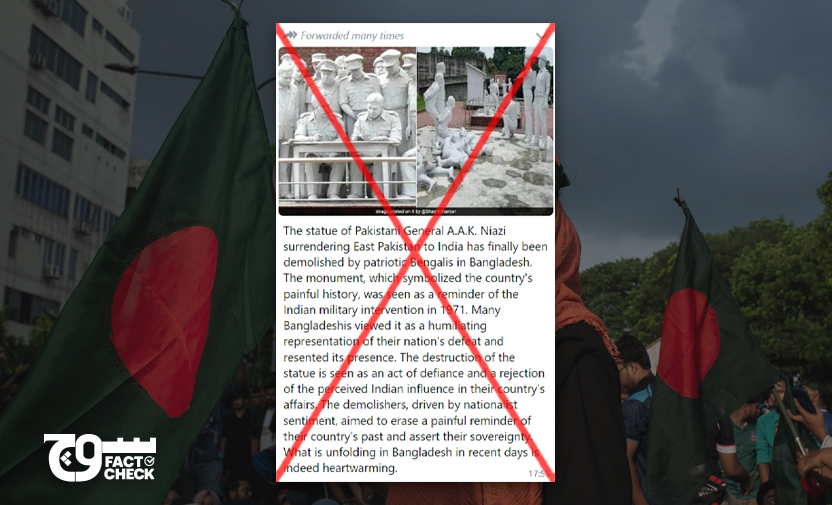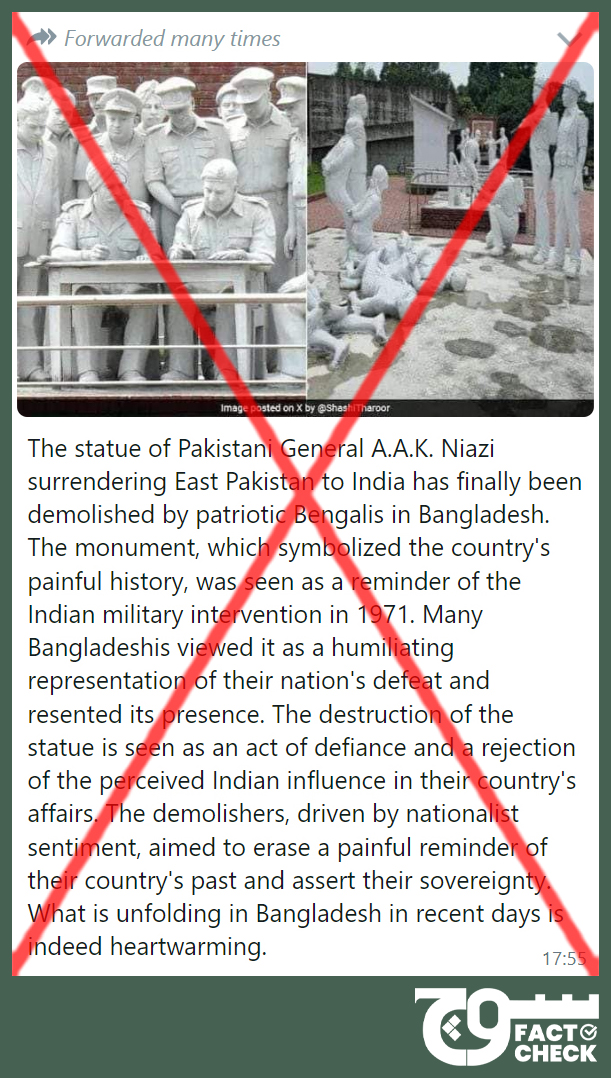
Claim: A group of statues in Bangladesh’s Mujibnagar Memorial Complex, commemorating the signing of the Instrument of Surrender between India and Pakistan in 1971, was “demolished” during the 2024 protests.
Fact: The statues in question were not “demolished” but just slightly damaged, according to evidence from news and video reports. A fact-checker in Bangladesh also confirmed the same.
On 16 August 2024, Soch Fact Check received a visual on WhatsApp comprising two pictures; one depicts the signing of the Instrument of Surrender in 1971 between India and Pakistan and the other shows destroyed figures on the ground.

The text can be read in full below:
“The statue of Pakistani General A.A.K. Niazi surrendering East Pakistan to India has finally been demolished by patriotic Bengalis in Bangladesh. The monument, which symbolized the country’s painful history, was seen as a reminder of the Indian military intervention in 1971. Many Bangladeshis viewed it as a humiliating representation of their nation’s defeat and resented its presence. The destruction of the statue is seen as an act of defiance and a rejection of the perceived Indian influence in their country’s affairs. The demolishers, driven by nationalist sentiment, aimed to erase a painful reminder of their country’s past and assert their sovereignty. What is unfolding in Bangladesh in recent days is indeed heartwarming.”
The group of figures are among many other statues located at the Bangabandhu Memorial Museum — also known as the Mujibnagar Liberation War Memorial Complex — in Meherpur in the country’s southwest. The monument is based on pictures from the well-known moment (archive) when Pakistan’s Lt Gen Amir Abdullah Khan Niazi — commonly known as A A K Niazi — signed the Instrument of Surrender that brought an end to the 1971 war and led to the birth of Bangladesh.
Mujibnagar was formerly known as Boidyanathtola and was renamed as such to honour Sheikh Mujibur Rahman, a Pakistani-Bengali politician who spearheaded Bangladesh’s independence movement. It is also the place where the “provisional government of independent Bangladesh was sworn in” on 17 April 1971.
India’s Lt Gen Jagjit Singh Aurora and All-India Radio (AIR) newscaster Surajit Sen are on the left and right of Niazi. The men standing immediately behind them include, from left to right: Vice Admiral Krishnan, Air Marshal Dewan, Lt Gen Sagat Singh, Maj Gen JFR Jacob, and Flying Officer SS Krishnamurthy, according to a copy of the image uploaded to Wikimedia Commons. The picture was taken on 16 December 1971.
The claim surfaced days after protesters entered the residence of the country’s former premier, Sheikh Hasina, who fled to India just before the building was breached.
Described by some as a dictator, Hasina served for a cumulative period of over 20 years, making her the longest-serving prime minister in Bangladesh’s history and the longest-serving woman head of the government in the world.
Student protests in Bangladesh
The Bangladesh protests began in June 2024 when the country’s supreme court overruled a decision by the government led by the former prime minister, Sheikh Hasina Wazed, to do away with a 30% public jobs quota for the 1971 fighters’ descendants in response to similar demonstrations in 2018. Students, who felt like their opportunities were restricted, demanded the system be made more merit-based.
The mass protests saw violence and clashes, arrests and detentions, and incidents of police firing directly at the demonstrators, which included students and teachers under the ‘Anti-discrimination Student Movement’ banner. They were also fuelled by discontent with the government and its suppression of rights. Multiple deaths and injuries were reported in the events that followed.
The government imposed a curfew and communications services were severely disrupted across Bangladesh in a move to quell the protests, according to multiple reports. Over 250 people were killed in the protests, according to Bengali-language newspaper Daily Manab Zamin. Among the deceased were police officers as well. Other sources stated that the death toll was over 400.
Eventually, Hasina — who had been in power since 2009 and previously ruled for another five years in the 1990s — resigned and fled to neighbouring India as a result of the pivotal move, which is now being called the “Gen Z revolution”. Bangladesh Army chief General Waker-Uz-Zaman announced her departure and immediately took charge, while President Mohammed Shahabuddin ordered the release of opposition leader and former prime minister, Khaleda Zia, from house arrest.
A few days later, on 8 August, Muhammad Yunus, an economist and Bangladesh’s Nobel laureate, was sworn in as the interim head of the state. His advisers include Nahid Islam and Asif Mahmud Shojib Bhuyain, the 26-year-old Dhaka University students who are among the leaders of the ‘Anti-discrimination Student Movement’.
Fact or Fiction?
Soch Fact Check looked up news reports from the protests, narrowing down our search to events at the Mujibnagar Memorial Complex, but only found articles about the destruction of over 600 statues; these can be accessed here and here.
An extensive investigation by a Bengali-language newspaper, Prothom Alo, found the number to be higher. Its correspondents “found information of 1,492 sculptures, relief sculptures (figures curved on a wall using ceramic or terracotta), murals and memorials being vandalised, set on fire and uprooted in 59 districts between 5 and 14 August”, it said, adding that most of these incidents took place on 5, 6 and 7 August 2024.
None of these news reports mention the memorial depicting the 1971 signing of the Instrument of Surrender being “demolished” or “destroyed”.
A prior report by Prothom Alo, from 11 August 2024, stated that “more than a hundred miscreants attacked the Mujibnagar Memorial Complex in Meherpur”, where the statues are located. The “riot” started on 5 August after the fall of Hasina’s government when “more than a hundred miscreants” armed with “rods, bamboos and hammers” entered the tourist site.
The publication quoted Humayun Ahmed, a member of the Bangladesh Ansar paramilitary force stationed at the Mujibnagar Memorial Complex, as confirming the number of statues destroyed. The article also included the same picture — credited to Prothom Alo — of destroyed statues as the one that appears on the right in the viral visual we’re investigating; however, according to its caption, it depicts “the brutal massacre of unarmed Bengalis by the Pakistani occupation forces in 1971”, not the 1971 signing of the Instrument of Surrender.
Soch Fact Check then reached out to dismislab fact-checker Minhaj Aman, who provided us links to video reports by Prothom Alo and another Bangladeshi media outlet called Jamuna TV, both of which show recent footage from the Mujibnagar Memorial Complex. The clip by the former depicts the memorial of the 1971 signing of the Instrument of Surrender intact, with only slight damage to the edges of the table, the hand of Niazi, the nose and hands of Aurora, the head and face of Sen, and the hand of the left-most person behind the two main Pakistani and Indian officers.
Aman also shared the link to a report by the United News of Bangladesh (UNB), which specifically stated that the attackers “slightly damaged the ‘Guard of Honor’ sculpture and the sculpture depicting Pakistan’s surrender on December 16, 1971”.
We also spoke to dismislab researcher Tamara Yesmin, who confirmed the location of the memorial and shared the 11 August 2024 report by Prothom Alo, which she said was “from a local reporter from Meherpur”.
We were able to locate both memorials on Google Maps here and here, indicating that they match the viral visuals, and confirm that the second one — on the right — does not show the one on the left after it was “demolished”.
The first one, embedded below, shows the 1971 signing of the Instrument of Surrender.
The second one, embedded below, depicts the memorial with the “fallen” figures, which, according to Prothom Alo, show “the atrocities by Pakistani army”.
During our investigation, we came across a 12 August 2024 post by Neeraj Rajput — the founder and editor-in-chief of The Final Assault, or TFA Media — on X (erstwhile Twitter), where he wrote:
“Don’t fell [sic] into trap of fake narrative. The ‘71 war sculptor memorial at #Mujibnagar in Khulna distt of #Bangladesh depicts people/statues lying as can be seen in my ‘18 tweet. Those are not destroyed statues. Many journalists, veterans and ex ministers are sharing it.”
Rajput’s post from 16 December 2018 can be viewed here.
A documentary available on the Mujibnagar Portal also confirmed that the photos in the viral visual are indeed of two different memorials and that the one on the right does not show the one on the left after it was “demolished”. The sculpture can be seen at the 20:28 mark and the 23:44 mark.
Soch Fact Check, therefore, concludes that the two images show different memorials and the claim is false. The accompanying text appears to bolster a pro-Pakistan narrative.
Virality
Soch Fact Check found that Indian National Congress (INC) leader Shashi Tharoor shared the same claim on X, writing:
“Sad to see images like this of statues at the 1971 Shaheed Memorial Complex, Mujibnagar, destroyed by anti-India vandals. This follows disgraceful attacks on the Indian cultural centre, temples and Hindu homes in several places, even as reports came in of Muslim civilians protecting other minority homes and places of worship.”
It is likely that the claim spread because of Tharoor’s X post since the visual included the text, “Image posted on X by @ShashiTharoor”, indicating that it was likely taken from a news report on the same.
Pakistan’s former information minister, Fawad Chaudhry, also fell for the false claim. Other X posts can be found here, here, here, and here.
X user @RealBababanaras, whose claims Soch Fact Check has debunked multiple times, also posted the visual here.
The claim was also shared on different news websites here, here, here, here, here, here, here, here, and here. It was posted here, here, and here on YouTube, here on Threads, and here and here on LinkedIn.
The visual was uploaded with the false claim here, here, here, here, here, here, and here on Facebook. In public groups on the platform, it was shared here, here, here, here, here, and here.
Conclusion: A group of statues in Bangladesh’s Mujibnagar Memorial Complex, commemorating the signing of the Instrument of Surrender between India and Pakistan in 1971, were just slightly damaged, not “demolished”, according to evidence from news and video reports. A fact-checker in Bangladesh also confirmed the same to Soch Fact Check.
Background image in cover photo: Tanvir Khondokar
To appeal against our fact-check, please send an email to appeals@sochfactcheck.com
